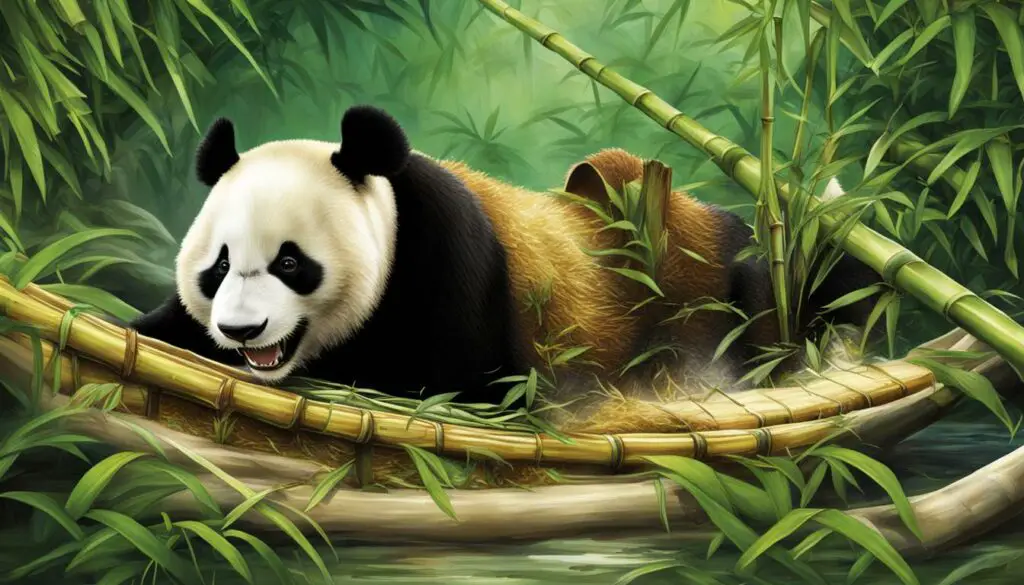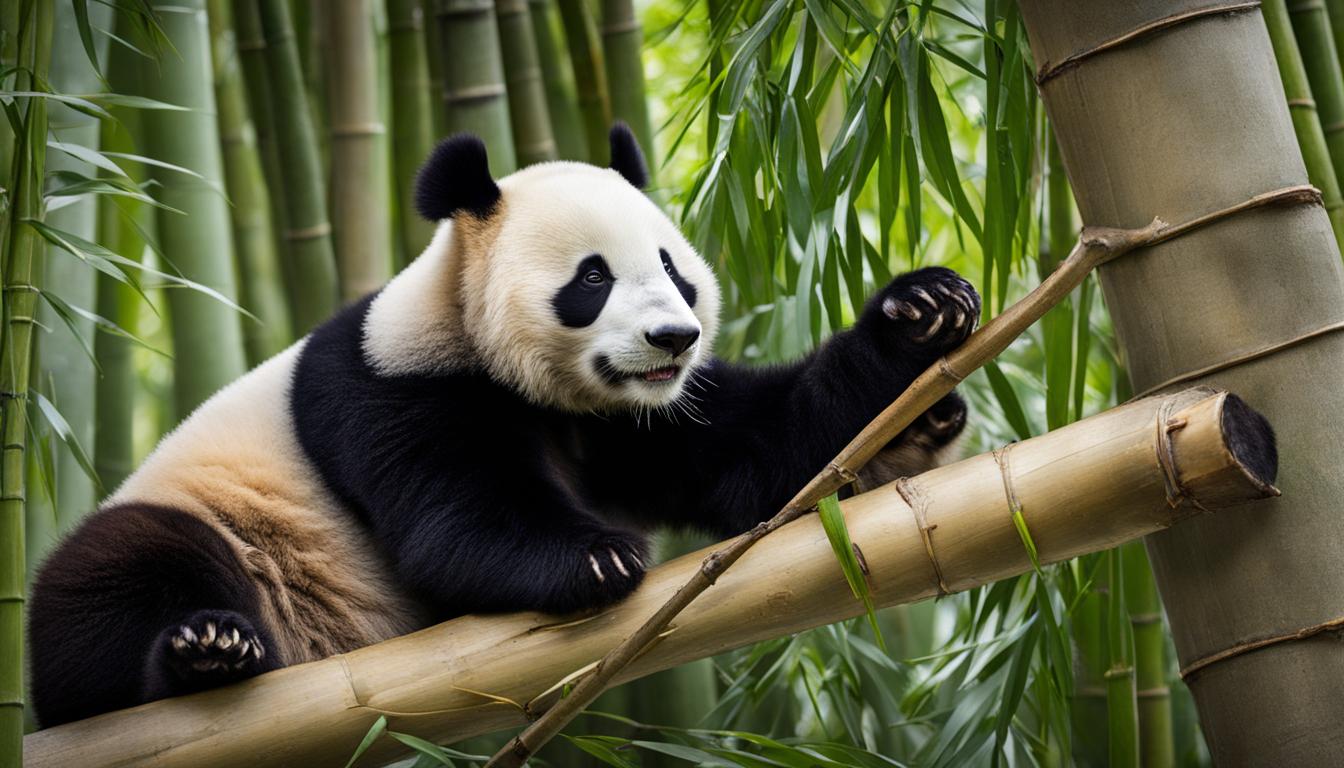Giant pandas, native to central China, have developed remarkable adaptations to thrive in their environments. As a vulnerable species with a rapidly declining population, understanding their adaptations is crucial for their preservation. In this article, we will explore the fascinating world of giant panda adaptations, from their unique diet to their physical and digestive system adaptations. Let’s dive in and discover the incredible ways giant pandas have evolved to survive.
The Giant Panda’s Unique Diet Adaptations
The giant panda has developed unique adaptations to survive on its specialized diet of bamboo. These adaptations, both genetic and physical, allow the panda to forage, consume, and digest bamboo effectively.
One remarkable adaptation is the panda’s “sixth toe,” which originates from its wrist bone. This extra digit provides the panda with better grip and dexterity when grasping and tearing bamboo shoots and leaves. The panda’s strong jaw muscles and enlarged cranial cavity also enable it to chew through the tough bamboo. Additionally, the panda’s molars are smoother and larger than those of other bears, as they are specifically adapted for grinding and processing bamboo.
The giant panda’s unique adaptations to its diet highlight the incredible diversity of nature’s solutions to ecological challenges.
These physical characteristics and genetic adaptations emphasize the panda’s specialization for a bamboo diet. By understanding and appreciating these unique adaptations, we can gain a deeper insight into the marvels of the natural world.
The Giant Panda’s Adaptations for Bamboo Consumption (Sample Table)
| Adaptation | Description |
|---|---|
| “Sixth toe” | An extra digit originating from the panda’s wrist bone, providing better grip for tearing bamboo shoots and leaves. |
| Strong jaw muscles | Enables the panda to chew through the tough bamboo. |
| Enlarged cranial cavity | Accommodates the strong jaw muscles necessary for bamboo consumption. |
| Smooth and large molars | Adapted for grinding and processing bamboo. |
The Giant Panda’s Digestive System Adaptations
The giant panda’s digestive system has undergone remarkable adaptations to handle its bamboo diet. These adaptations ensure that pandas can efficiently extract nutrients from bamboo and thrive in their natural habitat.
One key adaptation is the strong lining of the esophagus and stomach, which protects against damage from the tough bamboo fibers. This allows pandas to consume large quantities of bamboo without experiencing discomfort or digestive issues.
The giant panda’s digestive system has also evolved to handle the high cellulose content in bamboo. The shortened intestines enable swift passage of bamboo through the digestive tract, facilitating the extraction of nutrients. Additionally, the larger colon allows pandas to retain waste for longer periods, reducing the frequency of restroom breaks. This adaptation is especially crucial as pandas typically drink water only once a day, further minimizing the need for waste elimination.
“The giant panda’s digestive system has undergone remarkable adaptations to handle its bamboo diet.”
These digestive system adaptations are essential for pandas to survive on their specialized diet and play a significant role in their ability to thrive despite the challenges they face in their environment.

Giant Panda’s Digestive System Adaptations:
| Adaptation | Description |
|---|---|
| Strong lining of the esophagus and stomach | Protects against damage from tough bamboo fibers |
| Shortened intestines | Allows for swift passage of bamboo due to high cellulose content |
| Larger colon | Enables pandas to control waste for longer periods, reducing the need for frequent restroom breaks |
The Giant Panda’s Physical Adaptations for Bamboo Consumption
The giant panda’s physical features have evolved to support their bamboo consumption. One notable adaptation is the size of their head, which is larger compared to other bear species. This enlargement allows for the accommodation of strong jaw muscles necessary for chewing bamboo. Additionally, their molars are uniquely adapted to handle the tough bamboo fibers, setting them apart from their bear counterparts.
Another essential physical adaptation is the strengthening of their legs over time. The giant panda’s legs have evolved to carry their substantial weight as they forage for bamboo. These adaptations enable them to navigate their habitat and reach bamboo, which can weigh up to 40 pounds in a single day. The giant panda’s physical characteristics and adaptations are a testament to their specialized diet and survival strategies.
“The giant panda’s physical features, such as their large head and specially adapted molars, highlight their remarkable ability to consume bamboo,” says Dr. Wei Zhang, a leading expert in panda biology. “Their legs have also evolved to support their weight as they move through their habitat in search of bamboo.”
To further illustrate the physical adaptations of the giant panda, we present the following table:
| Physical Adaptation | Description |
|---|---|
| Large Head | Accommodates strong jaw muscles for chewing bamboo. |
| Adapted Molars | Specially designed for handling tough bamboo fibers. |
| Strong Legs | Evolved to support the panda’s weight as they forage for bamboo. |
The giant panda’s physical adaptations for bamboo consumption are not only fascinating but crucial for their survival in their natural habitats. By leveraging their specialized characteristics, they can efficiently obtain the necessary nutrients from bamboo, contributing to their overall health and well-being.
Giant Panda Conservation Efforts
Conservation efforts for giant pandas are of utmost importance due to their vulnerable status. Organizations like the Smithsonian’s National Zoo and Conservation Biology Institute, in collaboration with colleagues in China, are leading the way in giant panda conservation. Together, they conduct extensive research and studies on the ecology, behavior, and biology of giant pandas in their native habitat.
One of the key focus areas of giant panda conservation is breeding programs. These programs aim to increase the population of giant pandas in captivity and contribute to the preservation of the species. Zoos and breeding centers around the world play a significant role in these efforts by providing a safe and conducive environment for pandas to thrive.
In addition to population management, conservation efforts also focus on education and raising awareness about giant pandas. By promoting public knowledge and understanding of these magnificent creatures, conservationists hope to inspire people to take action and support conservation initiatives.
Giant Panda Conservation in Numbers
Let’s take a closer look at the impact of giant panda conservation efforts through some key statistics:
| Number of Giant Pandas in the Wild | Number of Giant Pandas in Captivity | Total Giant Panda Population |
|---|---|---|
| Approximately 1,864 | Around 600 | Approximately 2,464 |
These numbers highlight the critical conservation work being done to protect the giant panda species. With such a small population in the wild, every effort counts in ensuring their long-term survival.
“Conservation is a race against time, and every minute counts. We must continue to work together to protect and preserve the giant panda, an iconic species that symbolizes the importance of biodiversity conservation.” – Dr. Jane Goodall
Giant panda conservation is a global endeavor, involving dedicated researchers, conservationists, and individuals who care deeply about preserving our planet’s biodiversity. Through ongoing efforts, we can ensure a brighter future for giant pandas, allowing future generations to marvel at their beauty and importance in our natural world.
Other Adaptations of the Giant Panda
In addition to their unique diet and physical adaptations, giant pandas also exhibit other fascinating traits that contribute to their survival and reproductive success. One related species that showcases its own adaptations is the red panda, which inhabits the Himalayan forests. Red pandas have evolved to cope with cold weather and have a specialized diet consisting of bamboo and small animals.
The physical characteristics of the red panda enable it to thrive in its environment. With dense fur, the red panda has excellent insulation against the cold climates of the Himalayan forests. Its bushy tail helps it maintain balance while traversing tree branches and acts as a warm cover during chilly nights. These adaptations allow the red panda to efficiently regulate its body temperature and conserve energy.
Panda behavior also plays a significant role in their survival and reproductive adaptations. Giant pandas have a specific estrus cycle, occurring only once a year for a few days, during which they are fertile. This adaptation ensures successful mating and reproduction, as the limited window increases the chances of encountering a potential mate. Male pandas, in response to the scent of a receptive female, engage in scent marking behaviors and vocalizations to attract and court them. These behavioral adaptations contribute to the panda’s reproductive success and the continuation of their species.
| Red Panda Adaptations | Panda Behavior Adaptations | Panda Reproductive Adaptations |
|---|---|---|
| Dense fur for insulation | Specific estrus cycle | Increased fertility during estrus |
| Bushy tail for warmth and balance | Scent marking behaviors | Vocalizations to attract mates |
| Ability to cope with cold weather | Receptive to mating once a year | Increased chances of successful reproduction |
Overall, these additional adaptations further highlight the remarkable nature of giant pandas and their close relatives, the red pandas. Through their physical characteristics and unique behaviors, these animals have found ways to thrive in their respective habitats, ensuring their survival and the continuation of their species.
Conclusion
Giant pandas have developed remarkable adaptations that enable them to thrive in their environments. These adaptations, ranging from genetic to physical and digestive system traits, allow them to survive on a bamboo diet. The panda’s sixth toe, strong jaw muscles, and enlarged cranial cavity are just a few of the unique features that aid in their consumption of bamboo.
Conservation efforts led by the Smithsonian’s National Zoo and colleagues in China are crucial for the preservation of this vulnerable species. By understanding and appreciating these adaptations, we can work towards ensuring the long-term survival of giant pandas in both their natural habitats and captivity. These remarkable creatures serve as a reminder of the importance of biodiversity and the need for ongoing conservation efforts.
From their adaptations for bamboo consumption to their reproductive behaviors, giant pandas have captivated the world with their unique traits. By supporting initiatives focused on panda conservation and raising awareness about their adaptations, we can contribute to the continued protection and well-being of these incredible animals. Let us celebrate and cherish the giant panda’s adaptations, reminding ourselves that every effort counts in preserving the beauty and diversity of our natural world.
How Do Giant Pandas’ Adaptations Help Them Survive in Winter Conditions?
Giant pandas’ winter adaptations help them survive in harsh conditions. Their thick fur provides insulation, while their enlarged wrist bones act as snowshoes, aiding in walking through snow. Additionally, their specialized digestive system allows them to efficiently digest tough bamboo, their primary food source during winter.
FAQ
How many giant pandas are left in the world?
As of now, there are as few as 1,864 giant pandas living in their natural habitat in central China, while an additional 600 reside in zoos and breeding centers worldwide.
What is the role of the Smithsonian’s National Zoo in giant panda conservation?
The Smithsonian’s National Zoo and Conservation Biology Institute actively studies giant pandas’ biology, behavior, breeding, reproduction, and disease. They work closely with colleagues in China to advance global conservation efforts.
What is the giant panda’s diet?
The giant panda’s diet mainly consists of bamboo.
How do giant pandas adapt to consume bamboo?
Giant pandas have developed various adaptations, including a “sixth toe” that allows them to better grasp and tear bamboo shoots and leaves. They also have strong jaw muscles, an enlarged cranial cavity, and larger, smoother molars to chew through the tough bamboo.
How has the giant panda’s digestive system adapted to handle its bamboo diet?
The giant panda’s esophagus and stomach have strong linings to prevent damage from tough bamboo fibers. Their shortened intestines allow for swift passage of bamboo due to its high cellulose content. They also have a larger colon, which allows them to control waste for longer periods and reduces the frequency of restroom breaks.
What physical features of the giant panda support its bamboo consumption?
The giant panda has a larger head than other bear species, accommodating strong jaw muscles necessary for chewing bamboo. Their molars are adapted to handle tough bamboo, and their legs have strengthened over time to support their weight as they forage for up to 40 pounds of bamboo in a single day.
How important are conservation efforts for giant pandas?
Conservation efforts for giant pandas are crucial, as they are considered a vulnerable species. Organizations like the Smithsonian’s National Zoo and colleagues in China conduct ecology studies, work on breeding programs, and promote education and awareness to increase the population and preserve the species.
Do giant pandas exhibit any other unique traits or adaptations?
Yes, in addition to their bamboo adaptations, giant pandas also have reproductive adaptations, such as a specific estrus cycle and behaviors, to ensure successful mating and reproduction. Red pandas, which are closely related to giant pandas, have adaptations to survive in their Himalayan forest habitat, including dense fur and a bushy tail to cope with cold weather.
What can we do to help preserve giant pandas?
By understanding and appreciating the adaptations of giant pandas, we can support conservation efforts and promote education and awareness about these unique creatures. Supporting organizations involved in panda conservation and their habitat preservation is crucial for their long-term survival in both natural habitats and captivity.







